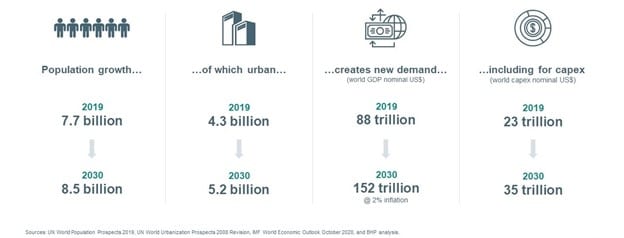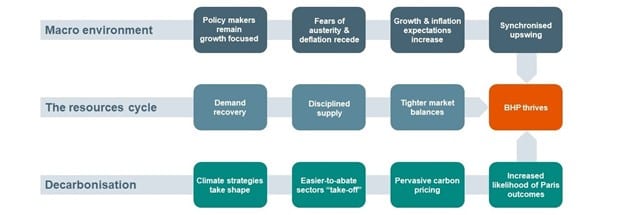Six months ago, at the time of our full year results for the 2020 financial year, we felt that the balance of probabilities indicated that the worst of the physical demand shock from COVID-19 was behind us. While some of our commodities have continued to face a challenging environment in absolute terms since that time, others have entered a clear recovery phase for both demand and price.
We expect the demand-supply balance to remain relatively tight in both iron ore and copper. The balance of risks for oil prices are tilted upwards, while metallurgical coal prices and differentials will be influenced as much by policy as by fundamentals. There is obviously still some residual uncertainty as to how vaccine deployment and the policy and behavioural response to the newer, more infectious strains of COVID-19 will interact over the coming quarters.
It is also notable that the early trends in the regional distribution of vaccines in calendar 2021 is similar to the distribution of stimulus policies in calendar 2020: the gap between wealthy economies and the bulk of the developing world is stark. So while the “uncertainty discount” in the risk appetite of households and businesses we have noted in previous communications is definitely fading, it is doing so in uneven fashion across the world. Those societies that are best equipped to rapidly mobilise resources under the pressure of a crisis – whether that be fiscal spending, hospital beds, vaccine production or cold storage logistics for the same – are distinctly advantaged over those with lesser capacity to move swiftly at scale.
Looking beyond the immediate picture to the medium-term, we continue to see the need for additional supply, both new and replacement, to be induced across most of the sectors in which we operate: notwithstanding the reality that COVID-19 has significantly lowered the starting point for demand across most of our exposures and in some instances has also left a temporary overhang of supply in its wake.
After a period of adjustment in which demand rebalances and supply is recalibrated, we anticipate that higher-cost supply will be required to enter the cost curve in our preferred growth commodities.
Looking beyond the immediate picture to the medium-term, we continue to see the need for additional supply, both new and replacement
In isolation, the demand shock associated with COVID-19, some aspects of which can be reasonably expected to endure beyond the immediate horizon in some regions and industries, is likely to delay the rational timing of such entries by a number of years versus pre-pandemic estimates. This timing must then be adjusted based on the expected duration and scale of the direct and indirect impacts of the virus on the supply landscape in each industry.
The combined impact of these factors could well delay the onset of inducement pricing in some industries but at this very early stage we do not feel that inducement prices themselves are in need of substantial revision.
The steepening of some industry cost curves that we monitor, albeit delayed from prior expectations, can reasonably be expected to reward disciplined owner-operators with higher quality assets.
In the medium and long term, on the demand side, we continue to see emerging Asia as an opportunity rich region. Later stage urbanisation and industrialisation in China, early-stage urbanisation in India and ASEAN and the multi-decadal impact of China’s Belt and Road initiative are all expected to provide additional demand for our products. As the true costs of a partial retreat from economic openness and a lack of climate action are progressively recognised, we anticipate a popular mandate for a more open international trading environment will eventually re-emerge, along with a concerted effort to confront climate change as a basic imperative.
We note that the younger generations that will define our future – both Millennials and Generation Z – are not only more concerned about a lack of action on climate change than their elders in both East and West, they are also more favourably disposed towards globalisation.
On that uplifting note, we confidently state that the basic elements of our positive long-term view remain in place.
Population growth, the infrastructure of decarbonisation and rising living standards are likely to drive demand for energy, metals and fertilisers for decades to come.
In the 2020s specifically, we expect global population to expand by 0.8 billion to 8.5 billion, urban population to also expand by 0.8 billion to 5.2 billion, nominal GDP to expand by $65 trillion to $152 trillion and capital spending to expand by $12 trillion to $35 trillion. Each of these basic fundamental indicators of resource demand will increase by more in absolute terms than they did across the 2010s.

Furthermore, with fiscal and monetary policy makers in key economies committing themselves to a reflationary agenda, the secular fundamentals that make our industry attractive may be amplified.
As illustrated by the scenario analysis in our Climate Change Report, if the world takes actions that limit global warming to 1.5 degrees it is advantageous for our portfolio.
Add to these constructive themes the fact that the industry has been disciplined in its allocation of capital over the last half decade. With this disciplined historical supply backdrop as a starting point, any sustained demand surprise seems likely to flow directly to tighter market balances.

Investment that seeks to abate emissions and/or adapt to, insure against and mitigate the impacts of climate change are expected to rise to become a material element of demand for parts of our portfolio. The electrification of transport and the decarbonisation of stationary power are expected to progress rapidly, as will the desire to tackle harder-to-abate emissions elsewhere in the energy, industrial and land-use systems. Comprehensive stewardship of the biosphere and ethical end-to-end supply chains will become even more important for earning and retaining community and investor trust.
The ability to provide and demonstrate social value to our operational and customer communities is both a core enabler of our strategy and a source of competitive advantage.
Against that backdrop, we are confident we have the right assets in the right commodities in the right jurisdictions, with attractive optionality, with demand diversified by end-use sector and geography, allied to the right social value proposition.
Even so, we remain alert to opportunities to expand our suite of options in attractive commodities that will perform well in the world we face today, and will remain resilient to, or prosper in, the world we expect to face tomorrow.
*This article is an excerpt from BHP’s Economic and Commodities Outlook (FY21 Half Year) report and has been republished with permission from BHP. The full report contains detailed analysis on steel and pig iron, iron ore, metallurgical coal, copper crude oil, LNG, Eastern Australia gas, energy coal, potash, nickel, and more. To read the full report, visit https://www.bhp.com/media-and-insights/prospects/2021/02/bhps-economic-and-commodity-outlook/












